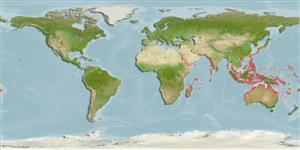>
Kurtiformes (Nurseryfishes, cardinalfishes.) >
Apogonidae (Cardinalfishes) > Apogoninae
Etymology: Neamia: Greek, neos = new + Greek, amia = a kind of shark (Ref. 45335).
More on authors: Smith & Radcliffe.
Environment: milieu / climate zone / depth range / distribution range
Ecologia
marino associati a barriera corallina; distribuzione batimetrica 3 - 5 m (Ref. 11890). Tropical
Indo-West Pacific: Red Sea and East Africa east to Fiji; north to Japan and south to Australia.
Size / Peso / Age
Maturity: Lm ? range ? - ? cm
Max length : 7.0 cm TL maschio/sesso non determinato; (Ref. 48635)
Spine dorsali (totale) : 9; Raggi dorsali molli (totale) : 9; Spine anali: 2; Raggi anali molli: 8. Body uniformly pinkish-yellow; dark radial cheek bars present around the lower part of the eyes. The last (8th) spine of the 1st dorsal fin joined to the second dorsal fin by a membrane. Caudal fin rounded. Further characterized by having small reddish spots on the body and fins (Ref. 93839).
Occurs inshore, near reefs (Ref. 7300). Secretive among boulders or under debris (Ref. 48635). Nocturnal species. Solitary (Ref 90102).
Life cycle and mating behavior
Maturità | Riproduzione | Deposizione | Uova | Fecundity | Larve
Distinct pairing during courtship and spawning (Ref. 205).
Randall, J.E., G.R. Allen and R.C. Steene, 1990. Fishes of the Great Barrier Reef and Coral Sea. University of Hawaii Press, Honolulu, Hawaii. 506 p. (Ref. 2334)
IUCN Red List Status (Ref. 130435: Version 2024-1)
Threat to humans
Harmless
Human uses
Pesca: di nessun interesse
Strumenti
Special reports
Download XML
Fonti Internet
Estimates based on models
Preferred temperature (Ref.
123201): 24.9 - 29.3, mean 28.4 °C (based on 2375 cells).
Phylogenetic diversity index (Ref.
82804): PD
50 = 0.5625 [Uniqueness, from 0.5 = low to 2.0 = high].
Bayesian length-weight: a=0.01445 (0.00680 - 0.03071), b=3.07 (2.89 - 3.25), in cm total length, based on LWR estimates for this (Sub)family-body shape (Ref.
93245).
Trophic level (Ref.
69278): 3.4 ±0.5 se; based on size and trophs of closest relatives
Resilienza (Ref.
120179): Alto, tempo minimo di raddoppiamento della popolazione meno di 15 mesi (Preliminary K or Fecundity.).
Fishing Vulnerability (Ref.
59153): Low vulnerability (10 of 100).
Nutrients (Ref.
124155): Calcium = 220 [102, 431] mg/100g; Iron = 1.26 [0.65, 2.39] mg/100g; Protein = 18.6 [17.3, 19.9] %; Omega3 = 0.109 [0.051, 0.239] g/100g; Selenium = 25.5 [10.4, 59.1] μg/100g; VitaminA = 55.1 [14.0, 227.1] μg/100g; Zinc = 2.33 [1.39, 3.78] mg/100g (wet weight);
